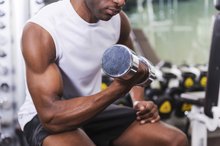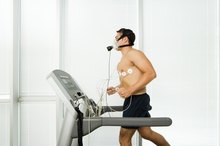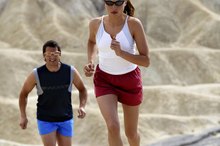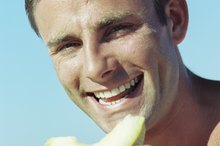Carbohydrates Burned During Exercises
You fuel your workout with carbohydrates, fats and protein, but carbohydrates are the body's preferred energy source. The body automatically seeks out carbs first as they are easiest to burn. In the absence of carbs, the body burns fat and then protein. The amount of carbohydrates burned during exercise depends on the type, duration and intensity of the exercise.
Simple Vs. Complex
Complex carbohydrates, such as oatmeal, sweet potatoes, potatoes, yams, whole grain rice, whole grain bread and whole grain pasta, provide slow-release energy. These carbohydrates are broken down and stored in the liver or muscles as glycogen, which is ready to be used to power your workouts. Simple carbohydrates from refined grains such as white rice, white bread, packaged breakfast cereals, fruit juice, sugar and honey break down swiftly into glucose and provide quick energy. If this energy is not going to fuel exercise, it becomes a surplus; it is transported by insulin to your fat stores and can result in unwanted weight gain.
- Complex carbohydrates, such as oatmeal, sweet potatoes, potatoes, yams, whole grain rice, whole grain bread and whole grain pasta, provide slow-release energy.
- Simple carbohydrates from refined grains such as white rice, white bread, packaged breakfast cereals, fruit juice, sugar and honey break down swiftly into glucose and provide quick energy.
Fuel for Intensity
The Digestive & Circulatory Systems Converting Food Into Energy
Learn More
Carbohydrate in the form of glycogen is stored in the liver and muscles. It is the primary source of energy for short, intense bouts of exercise such as weightlifting, sprinting or explosive activities that involve rapid contraction of the muscles. If glycogen stores become depleted, a sports drink that contains simple carbohydrates can deliver the carb energy you need. The body will quickly convert the carbs into glucose to be used by your muscles.
- Carbohydrate in the form of glycogen is stored in the liver and muscles.
- The body will quickly convert the carbs into glucose to be used by your muscles.
Cardiovascular Exercise
Between 50 and 60 percent of energy used in low intensity cardiovascular exercise comes from fat. Carbohydrates are mainly used during the first few minutes. The website ExRx.net says it takes 20 to 30 minutes of continuous cardiovascular exercise to use 50 percent carbohydrates and 50 percent fat. If you increase the intensity, such as incorporating short bursts of sprinting into a 30-minute jog, the energy contribution from carbohydrates increases as your muscles contract harder and faster.
- Between 50 and 60 percent of energy used in low intensity cardiovascular exercise comes from fat.
- The website ExRx.net says it takes 20 to 30 minutes of continuous cardiovascular exercise to use 50 percent carbohydrates and 50 percent fat.
Carbohydrate Depletion
Do Carbs or Protein Burn First?
Learn More
Your muscles continue to use carbohydrates, stored in the muscles and liver as glycogen, for energy during cardiovascular exercise. Once you've burned your glycogen stores and tapped into the fat, your muscles will be compelled to use protein as energy, which will eventually lead to a loss of muscle tissue. If you intend to do long cardiovascular sessions, eat plenty of complex carbohydrates a few hours before you exercise. This is called carb-loading and helps ensure you do not use up your stores of glycogen during prolonged periods of exercise.
- Your muscles continue to use carbohydrates, stored in the muscles and liver as glycogen, for energy during cardiovascular exercise.
- This is called carb-loading and helps ensure you do not use up your stores of glycogen during prolonged periods of exercise.
Related Articles
References
- ExRx.net: Substrate Utilization
- Murray B, Rosenbloom C. Fundamentals of glycogen metabolism for coaches and athletes. Nutr Rev. 2018;76(4):243-259. doi:10.1093/nutrit/nuy001
- Ferretti F, Mariani M. Simple vs. Complex Carbohydrate Dietary Patterns and the Global Overweight and Obesity Pandemic. Int J Environ Res Public Health. 2017;14(10) doi:10.3390/ijerph14101174
- Jensen J, Rustad P, Kolnes A, Lai Y. The Role of Skeletal Muscle Glycogen Breakdown for Regulation of Insulin Sensitivity by Exercise. Front Physiol. 2011;2. doi:10.3389/fphys.2011.00112
- Kanter M. High-Quality Carbohydrates and Physical Performance. Nutr Today. 2018 Jan;53(1):35-9. DOI: 10.1097/NT.0000000000000238.
Writer Bio
Ollie Odebunmi's involvement in fitness as a trainer and gym owner dates back to 1983. He published his first book on teenage fitness in December 2012. Odebunmi is a black belt in taekwondo and holds a bachelor's degree in economics from Kingston University in the United Kingdom.









